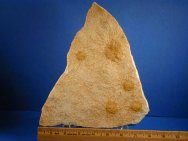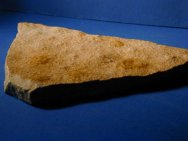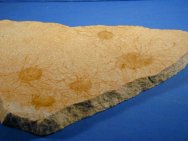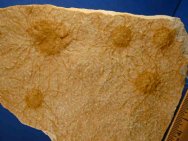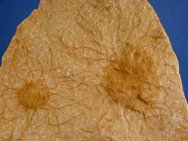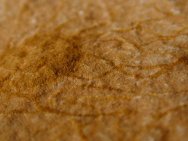Scyphozoa Jellyfish Fossils
Phylum Cnidaria, Subphylum Medusozoa, Class Scyphozoa
Geologic Time: Upper Cambrian (about 510 million years ago)
Size (25.4 mm = 1 inch): Matrix: 8.6 by 8 inches
Fossil Site: Krukowski Quarry, Elk Mound Group, Mount Simon Sandstone, near Mosinee, Wisconsin
Code: DD413
Price: $350.00 - sold
|
Being
comprised entirely of soft tissue (living jellyfish are about 95
% water), unlike animals with exoskeletons (e.g., trilobites) or
skeletons (vertebrates), jellyfish fossils are body fossils that
are impressions of the jellyfish. Such fossil impressions are rare,
especially from the Cambrian. Note that these jellyfish have tentacles
in the familiar radial symmetry of all Cnidarians. Jellyfish were
some of the most ferocious predators of the Cambrian marine environment.
These fossils are almost surely the result of a mass These jellyfish, five of them on the plate, come from a particular horizon in the Mount Simon Sandstone formation that also yields fascinating Diplichnites, huge Jellyfish (Medusae) and Climactichnites. Jelly fish body fossils are incredibly subtle, and therefore this specimen has been subtly stained. Members of Phylum Cnidaria (anemones, corals, jellyfish and sea pens) are ancient animals and has one of the longest fossil histories of metazoans. Though simple in body form, they remain ubiquitous and widespread in modern marine environments. The earliest forms in the fossil record appear in Ediacarian fauna of Southern Australia, which dates to the Precambrian some 600 million years ago. Their persistence is clear testament that old and simple animals can be enormously successful, and that the clique' "climbing the evolutionary ladder" is a misnomer; rather, life forms either adapts to the current and changing environment or perishes. Also see: Cambrian Shadows |

 stranding
on an ancient Cambrian beach, possibly caused by a storm surge.
stranding
on an ancient Cambrian beach, possibly caused by a storm surge.